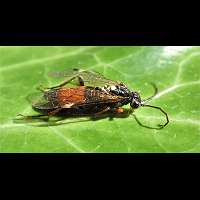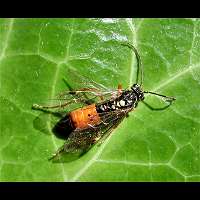Tenthredopsis scutellaris
We can't tell you anything about the Sawfly on this page, for we don't know what species it is, exactly. One thing is for sure, though. It belongs to the Tenthredopsis genus. In Holland this is a genus comprised of some 7 members. Some are very similar indeed. Most are rather large, elongated, black and yellowish red. They do look like a number of other Sawflies, especially those belonging to the genera Tenthredo en Rhogogaster, even though the members of the latter genus are usually green. The difference is easy to spot. Of these genera Tenthredopsis has the longest antennae by far.
We consulted two experts on Sawflies. The first was the British expert John Grearson. He did confirm this is a Tenthredopsis species indeed, but also knows it to be a non-British species. And as his knowledge of Continental Tenthredopsis species was somewhat limited, he wouldn't dare to suggest a name. Next expert was Dr. Andreas Taeger. He confirmed this was a Tenthredopsis species and believes it is one of the following four species: Tenthredopsis tarsata, Tenthredopsis scutellaris, Tenthredopsis litterata or Tenthredopsis ornata. Tenthredopsis scutellaris was on his mind, but he had to admit this was no more than a gamble and no certainty at all. So we consequently approached Dr. Ad Mol, the Dutch Sawfly expert and he states he agrees with Taeger: this most likely is Tenthredopsis scutellaris. So we put the animal here using that name, but not giving you absolute certainty.
As it turns out Tenthredopsis scutellaris is the most common Tenthredopsis species in our country. It is on the wing from mid-May to the end of June. The larvae can be found on a number of grasses.
We can't tell you anything about the Sawfly on this page, for we don't know what species it is, exactly. One thing is for sure, though. It belongs to the Tenthredopsis genus. In Holland this is a genus comprised of some 7 members. Some are very similar indeed. Most are rather large, elongated, black and yellowish red. They do look like a number of other Sawflies, especially those belonging to the genera Tenthredo en Rhogogaster, even though the members of the latter genus are usually green. The difference is easy to spot. Of these genera Tenthredopsis has the longest antennae by far.
We consulted two experts on Sawflies. The first was the British expert John Grearson. He did confirm this is a Tenthredopsis species indeed, but also knows it to be a non-British species. And as his knowledge of Continental Tenthredopsis species was somewhat limited, he wouldn't dare to suggest a name. Next expert was Dr. Andreas Taeger. He confirmed this was a Tenthredopsis species and believes it is one of the following four species: Tenthredopsis tarsata, Tenthredopsis scutellaris, Tenthredopsis litterata or Tenthredopsis ornata. Tenthredopsis scutellaris was on his mind, but he had to admit this was no more than a gamble and no certainty at all. So we consequently approached Dr. Ad Mol, the Dutch Sawfly expert and he states he agrees with Taeger: this most likely is Tenthredopsis scutellaris. So we put the animal here using that name, but not giving you absolute certainty.
As it turns out Tenthredopsis scutellaris is the most common Tenthredopsis species in our country. It is on the wing from mid-May to the end of June. The larvae can be found on a number of grasses.






